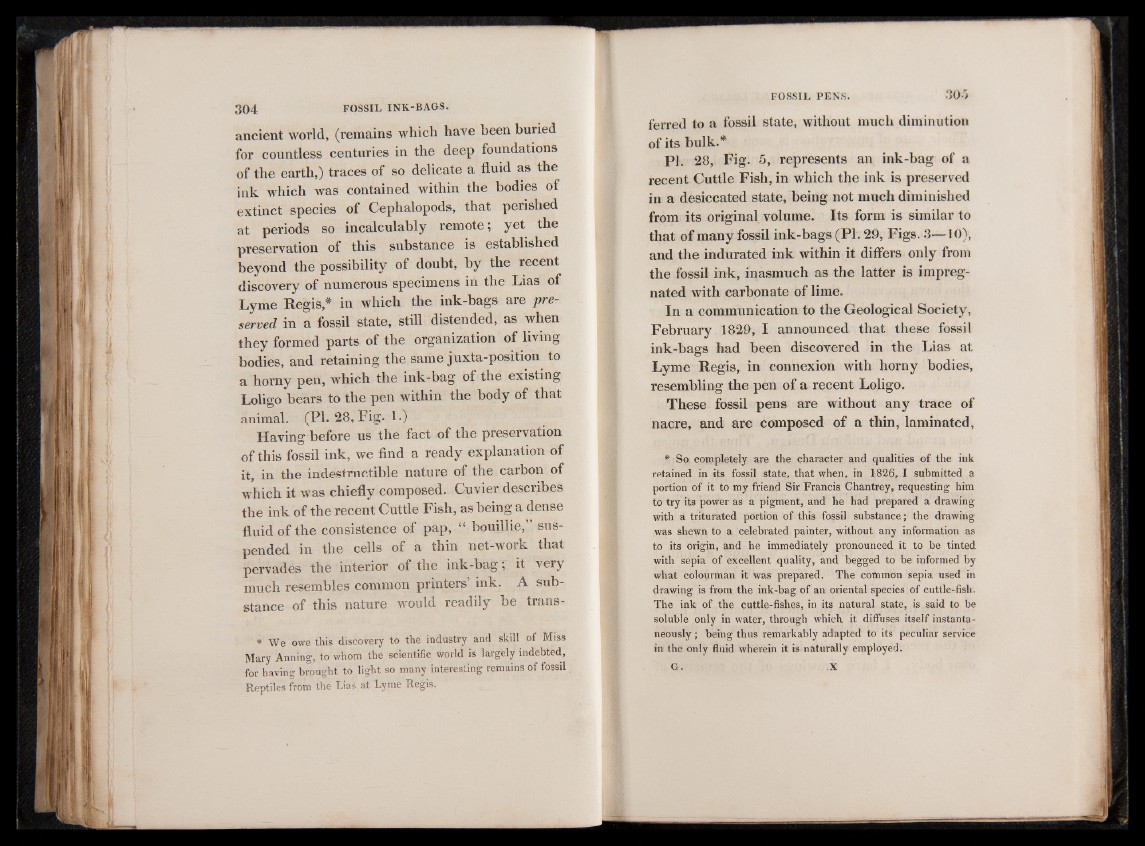
ancient world, (remains which have been buried
for countless centuries in the deep foundations
of the earth,) traces of so delicate a fluid as the
ink which was contained within the bodies of
extinct species of Cephalopods, that perished
at periods so incalculably remote; yet the
preservation of this substance is established
beyond the possibility of doubt, by the recent
discovery of numerous specimens in the Lias of
Lyme Regis,* in which the ink-bags are preserved
in a fossil state, still distended, as when
they formed parts of the organization of living
bodies, and retaining the same juxta-position to
a horny pen, which the ink-bag of the existing
Loligo bears to the pen within the body of that
animal. (PI. 28, Fig. 1.)
Having before us the fact of the preservation
of this fossil ink, we find a ready explanation of
it, in the indestructible nature of the carbon of
which it was chiefly composed. Cuvier describes
the ink of the recent Cuttle Fish, as being a dense
fluid of the consistence of pap, “ bouillie,” suspended
in the cells of a thin net-work that
pervades the interior of the ink-bag; it very
much resembles common printers ink. A substance
of this nature would readily be trans*
We owe this discovery to the industry and skill of Miss
Mary Anning, to whom the scientific world is largely indebted,
for having brought to light so many interesting remains of fossil
Reptiles from the Lias at Lyme Regis.
ferred to a fossil state, without much diminution
of its bulk.*
PI. 28, Fig. 5, represents an ink-bag of a
recent Cuttle Fish, in which the ink is preserved
in a desiccated state, being not much diminished
from its original volume. Its form is similar to
that of many fossil ink-bags (PI. 29, Figs. 3— 10),
and the indurated ink within it diflers only from
the fossil ink, inasmuch as the latter is impregnated
with carbonate of lime.
In a communication to the Geological Society,
February 1829, I announced that these fossil
ink-bags had been discovered in the Lias at
Lyme Regis, in connexion with horny bodies,
resembling the pen of a recent Loligo.
These fossil pens are without any trace of
nacre, and are composed of a thin, laminated,
* So completely are the character and qualities of the ink
retained in its fossil state, that when, in 1826, I submitted a
portion of it to my friend Sir Francis Chantrey, requesting him
to try its power as a pigment, and he had prepared a drawing
with a triturated portion of this fossil substance; the drawing
was shewn to a celebrated painter, without any information as
to its origin, and he immediately pronounced it to be tinted
with sepia of excellent quality, and begged to be informed by
what colourman it was prepared. The coftimon sepia used in
drawing is from the ink-bag of an oriental species of cuttle-fish.
The ink of the cuttle-fishes, in its natural state, is said to be
soluble only in water, through which it diffuses itself instantaneously
; being thus remarkably adapted to its peculiar service
in the only fluid wherein it is naturally employed.